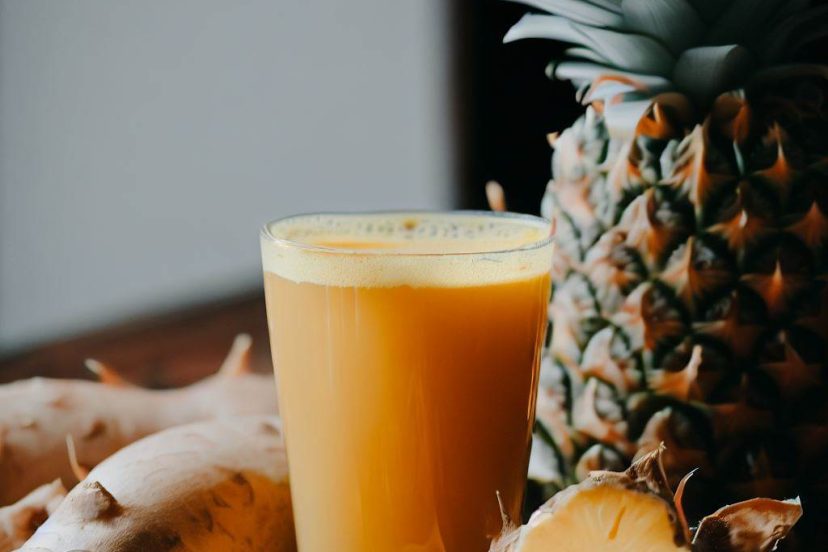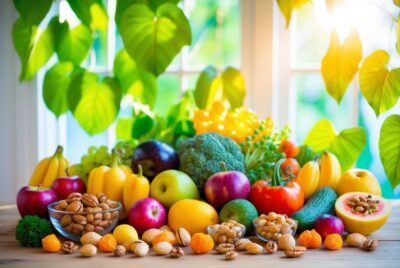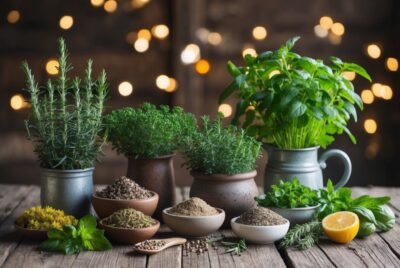Juicing for Inflammation: A Natural Path to Better Health
*We may earn a commission for purchases made using our links. Please see our disclosure to learn more.
Juicing for Inflammation: Natural Remedies to Reduce Swelling and Pain
Inflammation is the body’s natural response to protect itself against harm. However, when inflammation is chronic, it can lead to a host of health issues, including arthritis, heart disease, and even certain cancers. I’ve discovered that one approach to managing inflammation lies in what we consume. Juicing, in particular, has become a popular method to deliver a powerful punch of nutrients that can help combat inflammation.

Through my research and personal experience, I’ve learned that incorporating a variety of fruits and vegetables into juices can provide anti-inflammatory benefits. Ingredients like turmeric and ginger are potent anti-inflammatories, while pineapple is celebrated for its bromelain content, which may help to reduce swelling and pain. I also found that dark leafy greens like kale and spinach are packed with antioxidants that support a healthy inflammatory response.
I believe that juicing is a quick and efficient way to absorb these nutrients and can be easily integrated into daily routines. It’s important to note that while juicing can be beneficial, it should complement a balanced diet to help manage inflammation effectively.
Understanding Inflammation and its Effects on the Body

Inflammation is a vital part of the body’s immune response, but when it becomes chronic, it can lead to various health issues. Let’s explore how the immune system utilizes inflammation and the connection between chronic inflammation and diseases.
The Immune System and Inflammation
The immune system employs inflammation as a tool to combat foreign invaders such as bacteria and viruses. During this process, blood flow increases to the affected area, which can result in redness and warmth. White blood cells and substances they produce help protect the body from infection. Symptoms like swelling, pain, and heat are typical indications that my body is working to heal itself.
- Acute inflammation: This immediate response is noticeable and usually short-term, involving redness, warmth, swelling, and pain around tissues and joints after injuries or infections.
Chronic Inflammation and its Link to Diseases
Unlike acute inflammation, chronic inflammation is a long-term physiological response that can be less visible and more insidious. It occurs when the inflammatory response lingers, leaving the body in a constant state of alert. Over time, chronic inflammation may play a role in the development of certain diseases, such as heart disease, diabetes, cancer, and arthritis. This relationship is pivotal because it tells me that managing chronic inflammation is essential for maintaining long-term health.
- Heart disease: Persistent inflammation can lead to the buildup of plaque in the arteries, increasing the risk of heart attacks and strokes.
- Diabetes: Chronic inflammation may induce insulin resistance, which can result in type 2 diabetes.
- Cancer: Long-term inflammation has been associated with DNA damage and may contribute to the formation of cancerous cells.
- Arthritis: Inflammatory conditions such as rheumatoid arthritis involve continuous joint inflammation, leading to pain and stiffness.
The Role of Diet in Managing Inflammation

As someone who’s researched inflammation, I understand that one’s diet plays a crucial role in either exacerbating or reducing inflammation within the body.
Anti-Inflammatory Foods
The cornerstone of an anti-inflammatory diet includes a variety of fruits and vegetables. These are rich in antioxidants and flavonoids, which help combat inflammation. Incorporating leafy greens like spinach and kale is particularly beneficial as they are high in vitamins and minerals known for their anti-inflammatory properties. I also recommend a steady intake of nuts such as almonds and walnuts due to their healthy fats, which are vital in managing inflammation.
- Fruits: Blueberries, cherries, oranges
- Vegetables: Broccoli, Brussels sprouts
- Leafy Greens: Spinach, kale
- Nuts: Almonds, walnuts
Foods to Avoid
Conversely, there are foods I advise you to limit or avoid as part of an inflammation-reducing diet. Processed foods and those high in sugar can trigger or worsen inflammatory responses. My advice is to read labels carefully and minimize the intake of these items to support a healthy inflammatory response in the body.
- Processed Foods: Packaged snacks, fast food
- Sugary Foods: Soft drinks, candy
Juicing for Inflammation and the Relief

Juicing provides a concentrated way to consume vegetables and fruits, and when chosen correctly, these ingredients can offer anti-inflammatory benefits. I ensure to include produce rich in antioxidants and compounds that may help soothe inflammation.
Benefits of Juicing
Juicing allows for the intake of a dense nutrient profile from fruits and vegetables that might be difficult to consume in large, whole quantities. Ginger and turmeric are notable for their anti-inflammatory properties and can be conveniently consumed through juicing. Including these ingredients in a juice blend can offer a refreshing drink that may support the reduction of inflammation.
The Best Anti-Inflammatory Ingredients
In choosing ingredients for anti-inflammatory effects, I prioritize:
- Fruits: Pineapple (contains bromelain), Berries (packed with antioxidants), Oranges (rich in vitamin C), and Lemons (for flavonoids)
- Vegetables: Kale and Spinach (loaded with vitamins and minerals), Beets (contain betalains), Carrot and Cucumber (hydrating and nutrient-rich)
- Others: Celery and Green Apple (beneficial phytonutrients), Apple (fiber and vitamin C)
Ingredient Benefits Table
| Ingredient | Noted Compounds | Benefit |
| Ginger | Gingerol | May reduce muscular pain and soreness |
| Turmeric | Curcumin | Potent anti-inflammatory and antioxidant |
| Pineapple | Bromelain | Can help with digestion and inflammation |
| Carrot | Beta-carotene | Supports immune function and skin health |
| Beet | Betalains | Acts as an antioxidant with anti-inflammatory properties |
| Cucumber | Fisetin | Has potential anti-inflammatory effects |
When incorporating these ingredients into juices, I often blend colorful fruits with dark, leafy greens, aiming for a balance in flavor and nutritional value. The synergistic effect of combining these foods could enhance their individual anti-inflammatory properties.
Preparing Anti-Inflammatory Juices at Home

When I prepare anti-inflammatory juices at home, I focus on nutrition and flavor to ensure every sip supports my well-being. Using fresh ingredients rich in vitamins, minerals, and antioxidants, I can create powerful drinks that help fight inflammation.
Essential Juicing Tips
Choose the Right Juicer: A quality juicer is crucial. I prefer masticating juicers because they preserve nutrients better, but centrifugal juicers are also a good choice for their speed and efficiency.
Clean Ingredients: Always thoroughly wash fruits and vegetables. Organic produce is best to reduce pesticide exposure.
Optimal Nutrition: Focus on ingredients like leafy greens and colorful vegetables high in antioxidants, vitamin C, and beta-carotene to help reduce inflammation.
Hydration is Key: I ensure my juices have a hydrating component, such as cucumber or celery, which also provide minerals and additional nutrients.
Fiber Matters: While juicing removes most fiber, some juicers allow for more pulp. If I want to increase fiber intake, I include some of the leftover pulp back into the juice or use it in other recipes.
Simple Anti-Inflammatory Juice Recipes
1. Anti-Inflammatory Green Juice:
- Ingredients:
- 1 cup spinach
- 1 green apple
- 1/2 cucumber
- 2 stalks celery
- 1 inch ginger root
- 1/2 lemon
- Instructions:
- Roughly chop all ingredients.
- Juice greens, followed by apple, cucumber, celery, ginger, and lemon.
2. Tropical Turmeric Blend:
- Ingredients:
- 1 cup pineapple (for bromelain)
- 1 orange (for vitamin C)
- 1/4 tsp turmeric (for curcumin)
- 1 carrot (for beta-carotene)
- Instructions:
- Peel pineapple and orange, and cut into pieces that fit your juicer’s chute.
- Juice all ingredients together, stirring in turmeric last.
I carefully balance ingredients to ensure there’s a synergistic effect—nutrients work better together. The result is a delicious, anti-inflammatory beverage that’s both nurturing and enjoyable.
Integrating Juicing into Your Lifestyle for Better Health

As someone who prioritizes health, I understand that integrating juicing into my lifestyle can complement my overall health and aid in managing weight. The key is balancing juicing with whole foods and recognizing its role in a healthful diet.
Balancing Juicing with Whole Food Consumption
I am mindful of the fact that while juicing can enhance my nutrient intake, it is not a substitute for whole fruits and vegetables. Here’s why:
- Fiber: Whole foods provide dietary fiber, essential for gut health and digestion. Juicing removes most of the fiber, so I make sure to consume plenty of fibrous foods throughout the day.
- Nutrient Absorption: The body can absorb nutrients from whole foods more efficiently, which is crucial for my immune system and detox processes.
- Satiety: Eating whole foods can increase feelings of fullness, which is beneficial for weight management.
To maintain balance, I incorporate juicing as a supplementary part of my diet rather than the focal point.
Understanding Juicing and Weight Management
In my experience, juicing can be a helpful tool for weight loss, but it must be approached correctly:
- Caloric Intake: I am conscious of the calorie content in juices. Even if they are nutrient-dense, consuming high-calorie juices can lead to weight gain if I am not careful.
- Nutrient Profile: I select ingredients that support my digestion and cleanse my system from toxins, such as leafy greens and low-sugar fruits that aid in inflammation reduction.
- Regular Monitoring: To prevent unintended side effects, I monitor my body’s response to a juicing regimen, ensuring it doesn’t disrupt my overall health or gut balance.
By practicing mindful juicing, I find it a useful complement to my dietary habits, helping me to manage my health and weight effectively.
The Scientific Backing of Juicing for Inflammation
In my exploration of juicing and its impact on inflammation, I focus on empirical findings related to the anti-inflammatory compounds present in juices and what experts in the field have to say about their effects.
Research on Anti-Inflammatory Compounds in Juices
Research indicates that certain juices are rich in anti-inflammatory compounds, such as antioxidants, which play a crucial role in counteracting the damaging effects of free radicals in the body. For example, orange juice is particularly notable; a review has suggested that 100% orange juice influences markers of inflammation and oxidative stress. This effect is attributed to the juice’s content of vitamin C, flavonoids, and various phytonutrients.
I’ve also come across studies exploring bromelain, an enzyme found in pineapples, known for its anti-inflammatory properties potentially beneficial for diseases involving joint pain. The crucial aspect to consider is the bioavailability of these nutrients when they are consumed in juice form, as it appears this format can enhance the absorption of certain micronutrients and plant bioactives.
Key Nutrients in Anti-Inflammatory Juices:
- Vitamins: Such as Vitamin C from oranges.
- Phytonutrients: Flavonoids and other compounds.
- Enzymes: Bromelain found in pineapple juices.
Expert Opinions on Juicing and Inflammation Relief
Regarding expert views, it’s essential to dissect information with a discerning eye. While some health professionals acknowledge the potential benefits of juicing, they also caution against overestimations of its effects. For instance, according to some health sources, the anti-inflammatory effects of juicing, while present, should be viewed as a part of a balanced diet rather than a miraculous cure.
Experts advocate for the consumption of whole fruits and vegetables as well, ensuring a comprehensive intake of dietary fiber and nutrients. They emphasize the role of a varied diet to support the maintenance of health and the management of inflammation-related conditions.
In summary, juices can offer anti-inflammatory benefits through their antioxidant and nutrient content, though it’s imperative to regard them as a supplement to a varied and balanced diet, not a standalone solution.
Juicing for Inflammation Frequently Asked Questions
In this section, I cover some common inquiries about the role of juice in reducing inflammation and how it fits into an overall anti-inflammatory diet.
1. What types of juice are beneficial for reducing inflammation?
Juices rich in antioxidants and anti-inflammatory compounds are effective for reducing inflammation. Specifically, juices from fruits and vegetables like berries, cherries, oranges, and leafy greens are known for their beneficial properties.
2. Can certain juices help alleviate symptoms of arthritis?
Yes, certain juices can help alleviate arthritis symptoms. Ingredients like watermelon and basil have been reported to reduce swelling in arthritis sufferers due to their anti-inflammatory properties.
3. How do anti-inflammatory juices contribute to an anti-inflammatory diet?
Anti-inflammatory juices contribute to such a diet by providing a concentrated source of nutrients that fight inflammation. These nutrients from the juice of fresh produce support the body’s natural inflammation management processes.
4. In what ways can a juice cleanse impact inflammation in the body?
A juice cleanse, when done properly, can reset the digestive system and provide the body with high doses of nutrients known to reduce inflammation. However, the long-term impact of a juice cleanse on inflammation depends on overall diet and lifestyle.
5. What role does turmeric play in anti-inflammatory juice recipes?
Turmeric is a potent anti-inflammatory and antioxidant. When added to juice recipes, it not only imparts a warm, earthy flavor but also contributes curcumin, the active ingredient reputed for its significant anti-inflammatory effects.




